A: I have a letter from Robert Gauvin who wrote to us on a snowy night in Ottawa, Canada. He said “winter this year came late to most of Canada. The last few weeks winter has made up for its late arrival. Snow is still falling in early March and the temperature falls below -10DC during the day.”
B: From Indonesia, Pak Ning Tjang said the temperature in Binjai is 33 DC. It’s very hot. And Japan is becoming very warm and it’s spring soon, Toshiya Nishimura told us. Robert wrote “I know it doesn’t snow in Vietnam, but how cold can it get? Is the coast colder than in the mainland? How hot does Vietnam also get?”
A: Generally Vietnam doesn’t have snow. But earlier this year Vietnam’s northern part recorded the most historic freezing winter in about 40 years with the lowest temperature in some mountain regions dropping to -4DC. Northern provinces such as Lang Son, Lao Cai, Son La, and Ha Giang provinces were blanketed with snow for several days, with an average temperature of 10 DC. The unusual extreme weather caused great losses to cattle husbandry and plantation.
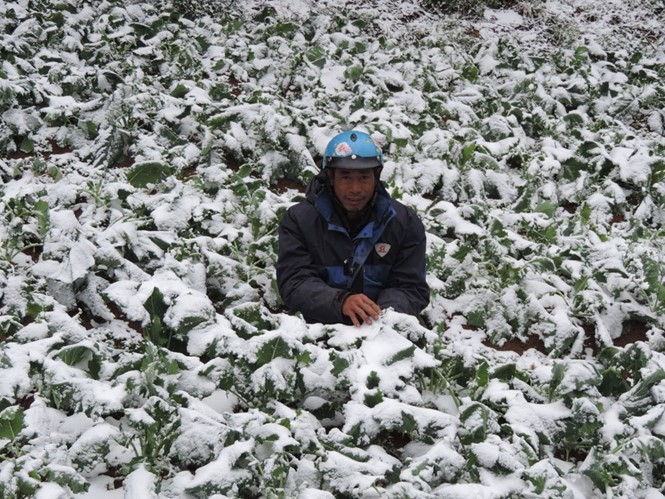 |
A farmer in Lao Cai province sits in his vegetable garden covered by snow in the 2016 winter
|
B: I cannot forget this winter because it has been the coldest since I was born. The National Meteorological Center said some parts of Hanoi had experienced the coldest weather since January 1977 when the temperature was at 5.7DC.
A: Vietnam has a very diverse climate because its land stretches over many degrees of longitude and its terrain varies from low lying coastal plains to almost 4,000 meter mountain peaks. Winter in the north is between November and March with average temperatures of 16oC. It is often dry and can be chilly. In the rainy season, from April to September, the average temperature is about 30oC. The hottest months are June and August.
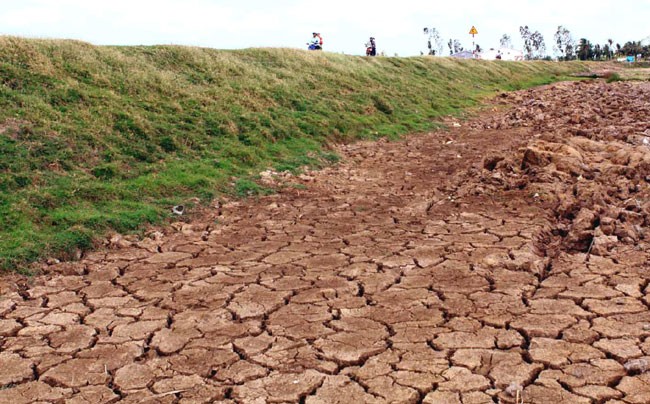 |
| Dried fields in the Mekong Delta |
B: The central region with two sub-regions, coastal lowlands and central highlands, can be seen as an in-between climatic area of the north and the south. The coastal strip is usually dry and hotter than the rest in the summer with possible temperature reaching 40 DC, as the Truong Son Mountains prevents most rainfall of south-western monsoon from April to October. From July to November, strong and unpredictable typhoons can hit some of the coastal regions with sometimes devastating results.
A: The temperatures in the south, or the Mekong Delta, are fairly constant all year round, ranging from 25oC – 30oC. The dry season is from November to April and the wet season from May to October. Due to climate change, the Mekong Delta is suffering prolonged droughts which causes severe saltwater infiltration. The water level in many branches of the Mekong river has dropped drastically.
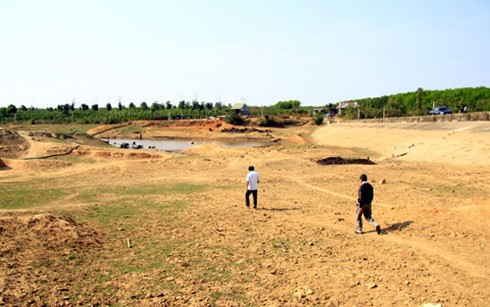 |
Reservoir No. C19 in Kon Tum province is dried up
|
B: Scientists blame the ongoing 2015-2016 El Nino weather phenomenon, one of the most powerful on record, for the current drought. Water shortages have also hampered agriculture in nearby Cambodia, Laos, Thailand and Myanmar. The national weather forecast center expects that it will begin to rain in late April and early May and quench dried rivers and fields in the Mekong’s low reaches.
A: Now let’s continue to read Robert Gauvin’s reception report for the program o March 3 on the frequency of 6175 khz. “Reception of your broadcasts is usually average to good on most nights. Shortwave reception was poorer than usual this winter. But the Voice of Vietnam was able to still coming through on most nights.”
B: Robert said his last QSL from Vietnam is from quite a long time ago. He’d like to bring it more up to date. Congratulations! You’re one of the first listeners receiving our new QSL designs.
A: We have a new collection of 8 QSL cards with images of Long Bien bridge, built by the French in 1899, Ly Son island, peach blossom in Moc Chau, terraced rice fields in Sapa, Hoai river in Hoi An, Ban Gioc waterfall in Lang Son province, Thuan Phuoc bridge in Danang city, and a photo of the female staff from the English section.
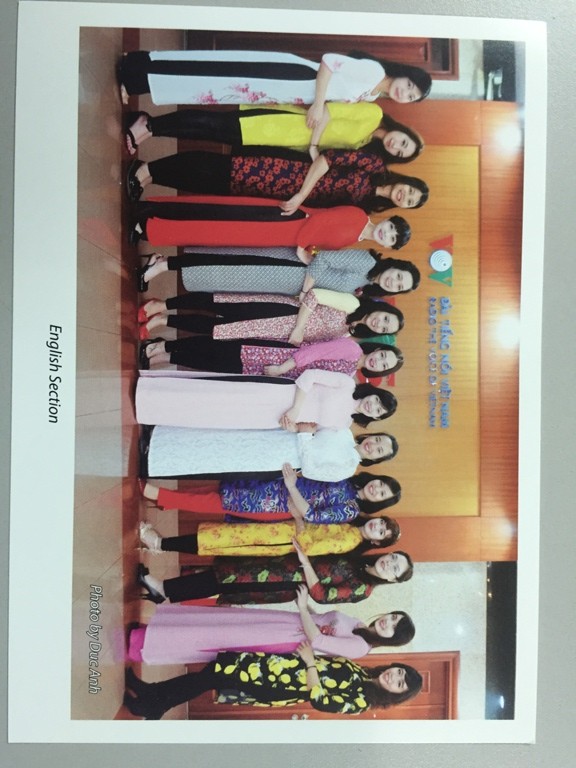 |
A QSL design with the photo of the female staff of VOV's English Program, World Service
|
B: You’ll definitely want to collect all 8 designs. Japanese listener Yoshikazu Suzuki reported listening to a program on March 22 on 12020 khz and rating SINPO at 35443. It was the best condition time in his place in Shibukawa, Gunma province, Yoshikazu said. He has map-designed QSL cards and wants to have different designs.
A: Your report has sufficient information and we’ll definitely send you a new QSL card. Here I have a letter from Richard Nowak of the US. He submitted a reception report for Friday night’s show which began with the news. There was a very interesting segment on climate change and how it affects life in the Mekong Delta. 39% of the Mekong Delta will be under water if the sea keeps rising. Richard said “I didn’t realize the situation was this bad. I hope the world governments can stop this from getting worse.”
B: We hope so too, Richard. The Mekong Delta is critically important to Vietnam’s national agricultural production. It produces 50% of the nation’s rice, 80% of the nation’s fruit, and 60% of the nation’s fish, making it the largest agriculture and aquaculture production region in Vietnam. Overall, 46% of the total amount of food produced in Vietnam comes from the region. A large volume of the agricultural output of the Mekong Delta is exported throughout Southeast Asia, making it a crucial agricultural source for other countries in the region.
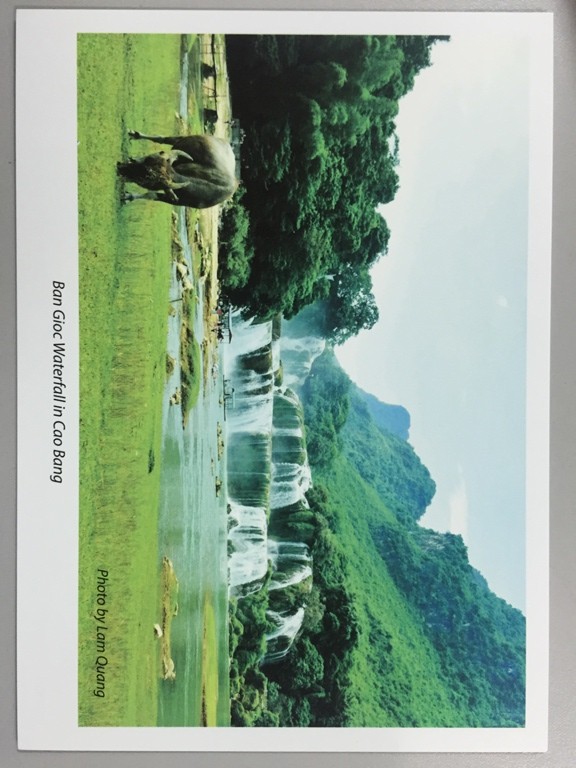 |
| Another QSL design of VOV's English Program |
A: Increasing levels of saltwater intrusion in the Mekong Delta pose a real threat to its agricultural output. It also poses potential risks to social and political unrest as resource shortages may affect the food security and livelihoods of residents of the regions. From the Republic of Ireland, Calvin O’Callaghan said he listened to VOV’s program on January 3 on 5955 khz via a transmitter in Moosbrunn. He said the program was about Vietnam’s culture and music. He especially liked the song “bamboo in the wind”.
B: David Ansell in England listened to VOV on March 10 on 7280 khz and rated SINPO at 45533. He commented “The news coverage is good. I like the Vietnamese music. I’ll continue to listen to VOV regularly. Thank you for your good and useful program and remaining on shortwave.”
A: I was surprised to receive 4 letters from Toshiya Nishimura in Japan. He reported listening to our shows on March 5th, 10th, 12th, and 19th on 12020 khz. There was little to acceptable noise. Thank you very much Toshiya for sending us these regular reports. We hope the reception will be better in the summer.
B: Finally we’d like to remind you of some frequency changes for VOV’s summer broadcasts. VOV’s relayed broadcast from Moosbrunn, Woofferton, and Dhabayya to Europe at 17:00 UTC will be on 9625 khz. Our broadcast from Woofferton and Cypress Creek to Eastern America and the Caribbean at 01:00 UTC and 02:30 UTC will be on 12005 khz. And our broadcasts to Central America and the Caribbean at 03:30 UTC will be on 6175 kHz.
A: If you haven’t jotted down the changes, please go to our website at www.vovworld.vn to confirm them. We’ve sent frequency lists individually by emails and postal mail. We hope to receive your feedback soon.
B: Thank you all very much for listening. Please send your reports to English Section, Overseas Service, Voice of Vietnam, 45 Ba Trieu Street, Hanoi, Vietnam. Our email address is englishsection@vov.org.vn. Thank you for listening and join us again next Wednesday for another Letter Box show. Goodbye from both of us to all of you.